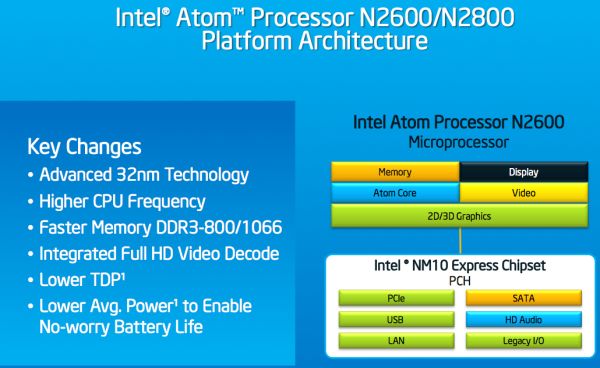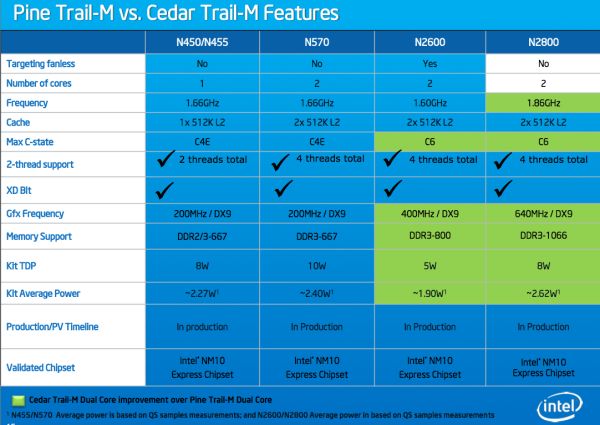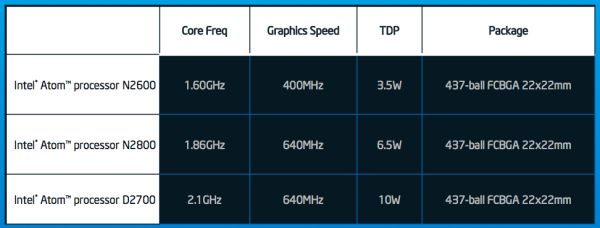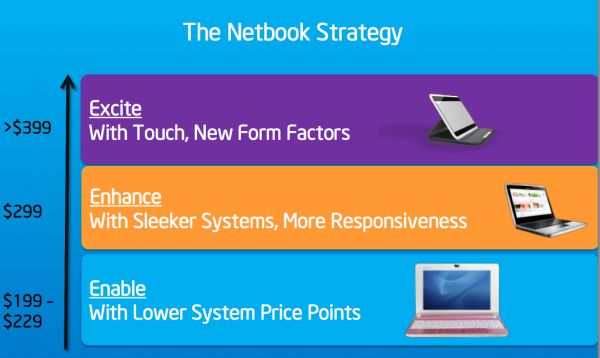Intel's Atom N2600, N2800 & D2700: Cedar Trail, The Heart of the 2012 Netbook
by Anand Lal Shimpi on December 28, 2011 11:00 AM EST- Posted in
- CPUs
- Intel
- Atom
- Cedar Trail
Netbooks aren't dead, but they're not quite the hip topic of discussion they were a few years ago. The focus on cost conscious computing hasn't changed since the introduction of the first netbook, but the maturity of tablets has. Intel still sees the netbook segment as a profitable one (for itself) through 2012, although I'm fully expecting the line between netbook and convertible tablet to blur after the launch of Windows 8.
Atom has been at the heart of nearly all netbooks since the segment's inception. We've seen only one major platform shift since then: from the original 2008 Atom platform to Pine Trail. Pine Trail integrated the GPU and memory controller without significantly changing the Atom architecture. Today Intel is officially announcing its next major netbook platform shift: Cedar Trail.
While the original Atom and Pineview (Pine Trail's Atom) were built on Intel's 45nm process, Cedar Trail moves to 32nm. Cedar Trail's SoC shrinks to 56mm2, finally making it smaller than AMD's Zacate APU. The underlying CPU architecture hasn't really changed, nor have cache sizes (512KB L2 per core) or clock speeds (1.66GHz and 1.86GHz parts available), so what this is really about is a reduction in power consumption.
There are three Atom CPUs being offered as a part of Cedar Trail: the N2600, N2800 and D2700. Just as before, the N-series are for netbooks while the D-series are for desktops. All of the Cedar Trail Atoms are dual-core parts, but they all slot into the same power envelope as the old single-core Pine Trial platforms (5 - 8W). The only exception is the D2700 which is a 10W platform. Note that this is the total TDP for the Atom SoC + the NM10 Express chipset (providing USB, LAN, PCIe, etc...).
The spec breakdown is below:
Given the same number of cores and the same clock speeds, CPU performance shouldn't go up compared to Pine Trail. Since everything is now dual-core we should see a boost at the low end, but I wouldn't expect to see CPU performance that's better than Zacate.
Cedar Trail now supports DDR3-800 and 1066 (up from 667MHz max data rates before). The bigger change is the GPU. The GMA 3150 used in Pine Trail was an Intel Gen graphics derivative (45nm GMA 3100), however Cedar Trail now features a PowerVR SGX 545 sourced from Imagination Technologies. At 640MHz in the N2800, we've never seen the SGX 545 run at anywhere near this clock speed before so it'll be interesting to see how well it performs. Intel is claiming a > 2x GPU performance improvement compared to the GMA 3150 in Pine Trail in 3DMark 06. The big question is Windows driver maturity, but we'll find out soon enough as systems based on Cedar Trail are in production now and are expected to ship in early 2012. Expect to see Cedar Trail netbooks from ASUS, Acer, HP, Lenovo, Samsung and Toshiba for starters.
The new graphics block also includes support for H.264 video decode acceleration (we're still digging for specifics) as well as Intel Wireless Display technology. Note that WiDi support will vary depending on the system and price point:
Intel is expecting the vast majority of Cedar Trail netbooks to be sold in the $199 - $229 price point. At $299 is where you'll likely find features like WiDi as well as potentially fanless designs. Don't expect any of those new form factors at $399 until the later part of next year, likely coinciding with Windows 8's release.
Overall the addition of HD video decode support and lower power consumption are both nice features to have, but I'm skeptical as to whether this will be enough to carry Intel based netbooks throughout the majority of 2012. Atom is in dire need of an architecture update (something we'll get in 2013) and the netbook as a platform is in need of a refresh. I do hope to see some manufacturers taking risks with slim, fanless Cedar Trail based designs next year but we'll have to wait and see if they're any good.














38 Comments
View All Comments
Stuka87 - Wednesday, December 28, 2011 - link
While I think this chip should have better battery life than an E350, I am really wondering if its going to be any faster. The graphics certainly are less than spectacular, even my phone has far faster graphics (543MP2) and it runs a lower resolution.Its almost comical how Intel's high end parts are blind blowing fast, yet their low end stuff is just so lacking in any sort of real updates. Combined with the delays that it has had, they are leaving this market wide open for AMD.
madmilk - Wednesday, December 28, 2011 - link
I highly doubt your phone's graphics are "far faster". Remember, typically PowerVR GPUs are clocked at 200MHz, maybe 300 at most. This thing has a SGX545 running at 640MHz, should more than compensate for being single core.That said, PowerVR Windows drivers... Even worse than Intel's, while AMD and nVidia are both on another level.
Boissez - Thursday, December 29, 2011 - link
The tablet-friendly low-TDP atom part has a PowerVR running @400MHz, meanwhile the TI OMAP 4460 (eg. Galaxy Nexus, Moto RAZR) has the same chip running @384Mhz, just barely slower. But then both the Apple A5 and Samsung Exynos are far superior in terms of graphical prowess.dealcorn - Wednesday, December 28, 2011 - link
With the N2600's ~1.9 watt kit average power requirement, it looks like maybe you could add 512 MB of RAM and an Intel 320 SSD for a home server that draws about 3 watts at the wall. On the other hand, I have never seen anyone look at power supply efficiency at these output levels.Currently I draw about 22 watts for a router/firewall/p2p daemon station and electricity costs $10/watt for 3 years 24/7 use. Switching to 3 watts saves me $190 in electric bills every 3 years. I have a soft spot for free stuff that works.
There is some disagreement whether AMD's recent success in the netbook space is due to their gaming excellence or the fact that they do 1080p and Atom does not. The release of Cedar Trail should provide more insight on that question. I never really bought the line that netbooks are the next credible gaming platform.
tpi2009 - Thursday, December 29, 2011 - link
Hi Anand, good to know the new Atoms are coming.There is one error in the article:
"The only exception is the D2700 which is a 10W platform. Note that this is the total TDP for the Atom SoC + the NM10 Express chipset (providing USB, LAN, PCIe, etc...). "
This can't be the case with the D2700 because, as you will notice in a table below that has CPU - only TDPs, the D2700 is rated at 10w for the CPU, so the CPU + NM10 chipset will use more power.
Cheers, and a great 2012 to you and the rest of the team!
Malih - Thursday, December 29, 2011 - link
wow, PowerVR really? Does that mean gaming is not an option with the new Atom...?I wonder how PowerVR will handle Windows XP drivers.
Stuka87 - Thursday, December 29, 2011 - link
It wont would be my guess. You can't buy new Netbooks with XP anymore (unless they are just left over NOS or something). With as many driver issues as Intel has had with this chip, I doubt they are going to put them time into making an old unsupported OS work.Shadowmaster625 - Thursday, December 29, 2011 - link
Why didnt intel integrate the chipset? I think they could have gotten total platform power down to 3 watts. This is almost 2012 after all.dealcorn - Thursday, December 29, 2011 - link
If you look at the first really big blue box above, it is using complicated words to say that this System on a Chip ("SOC") is fully integrated including everything that should be there. Out of deference to a former Alaska governor some consider it impolite to use the "R" word. In your case, I suspect people would understand your intent if you said, for example, "Intel is really mirror."Shadowmaster625 - Friday, December 30, 2011 - link
http://i1-news.softpedia-static.com/images/news2/I...Sure looks like two chips to me. Can we get some clarification here?